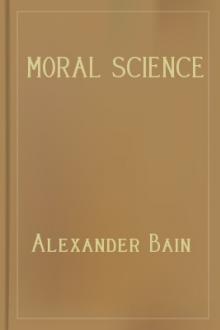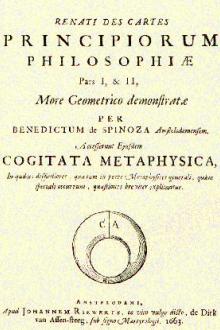Hegel's Philosophy of Mind, Georg Wilhelm Friedrich Hegel [big ebook reader .txt] 📗

- Author: Georg Wilhelm Friedrich Hegel
- Performer: -
Book online «Hegel's Philosophy of Mind, Georg Wilhelm Friedrich Hegel [big ebook reader .txt] 📗». Author Georg Wilhelm Friedrich Hegel
But with so much common in the general plan, the two thinkers differ profoundly in their special mode of carrying out the task. Or, rather, they turn their strength on different departments of the whole. Herbart's great practical interest had been the theory of education: “paedagogic” is the subject of his first important writings. The inner history of ideas—the processes which are based on the interaction of elements in the individual soul—are what he specially traces. Hegel's interests, on the contrary, are more towards the greater process, the unities of historical life, and the correlations of the powers of art, religion, and philosophy that work therein. He turns to the macrocosm, almost as naturally as Herbart does to the microcosm. Thus, even in Ethics, while Herbart gives a delicate analysis of the distinct aspects or elements in the Ethical idea,—the diverse headings under which the disinterested spectator within the breast measures with purely aesthetic [pg lxviii] eye his approach to unity and strength of purpose, Hegel seems to hurry away from the field of moral sense or conscience to throw himself on the social and political organisation of the moral life. The General Paedagogic of Herbart has its pendant in Hegel's Philosophy of Law and of History.
At an early period Herbart had become impressed with the necessity of applying mathematics to psychology29. To the usual objection, that psychical facts do not admit of measurement, he had a ready reply. We can calculate even on hypothetical assumptions: indeed, could we measure, we should scarcely take the trouble to calculate30. To calculate (i.e. to deduce mathematically) is to perform a general experiment, and to perform it in the medium where there is least likelihood of error or disturbance. There may be anomalies enough apparent in the mental life: there may be the great anomalies of Genius and of Freedom of Will; but the Newton and the Kepler of psychology will show by calculation on assumed conditions of psychic nature that these aberrations can be explained by mechanical laws. “The human Soul is no puppet-theatre: our wishes and resolutions are no marionettes: no juggler stands behind; but our true and proper life lies in our volition, and this life has its rule not outside, but in itself: it has its own purely mental rule, by no means borrowed from the material world. But this rule is in it sure and fixed; and on account of this its fixed quality it has more similarity to (what is otherwise heterogeneous) the laws of impact and pressure than to the marvels of an alleged inexplicable freedom31.”
Psychology then deals with a real, which exhibits [pg lxix] phenomena analogous in several respects to those discussed by statics and mechanics. Its foundation is a statics and mechanics of the Soul,—as this real is called. We begin by presupposing as the ultimate reality, underlying the factitious and generally imperfect unity of self-consciousness and mind, an essential and primary unity—the unity of an absolutely simple or individual point of being—a real point which amongst other points asserts itself, maintains itself. It has a character of its own, but that character it only shows in and through a development conditioned by external influences. The specific nature of the soul-reality is to be representative, to produce, or manifest itself in, ideas (Vorstellungen). But the character only emerges into actuality in the conflict of the soul-atom with other ultimate realities in the congregation of things. A soul per se or isolated is not possessed of ideas. It is merely blank, undeveloped, formal unity, of which nothing can be said. But like other realities it defines and characterises itself by antithesis, by resistance: it shows what it is by its behaviour in the struggle for existence. It acts in self-defence: and its peculiar style or weapon of self-defence is an idea or representation. The way the Soul maintains itself is by turning the assailant into an idea32: and each idea is therefore a Selbsterhaltung of the Soul. The Soul is thus enriched—to appearance or incidentally: and the assailant is annexed. In this way the one Soul may develop or evolve or express an innumerable variety of ideas: for in response to whatever it meets, the living and active Soul ideates, or gives rise to a representation. Thus, while the soul is [pg lxx] one, its ideas or representations are many. Taken separately, they each express the psychic self-conservation. But brought in relation with each other, as so many acts or self-affirmations of the one soul, they behave as forces, and tend to thwart or check each other. It is as forces, as reciprocally arresting or fostering each other, that ideas are objects of science. When a representation is thus held in check, it is reduced to a mere endeavour or active tendency to represent. Thus there arises a distinction between representations proper, and those imperfect states or acts which are partly or wholly held in abeyance. But the latent phase of an idea is as essential to a thorough understanding of it as what appears. It is the great blunder of empirical psychology to ignore what is sunk below the surface of consciousness. And to Herbart consciousness is not the condition but rather the product of ideas, which are primarily forces.
But representations are not merely in opposition,—impinging and resisting. The same reason which makes them resist, viz. that they are or would fain be acts of the one soul, but are more or less incompatible, leads them in other circumstances to form combinations with each other. These combinations are of two sorts. They are, first, complications, or “complexions”: a number of ideas combine by quasi-addition and juxtaposition to form a total. Second, there is fusion: ideas presenting certain degrees of contrast enter into a union where the parts are no longer separately perceptible. It is easy to see how the problems of psychology now assume the form of a statics and mechanics of the mind. Quantitative data are to be sought in the strength of each separate single idea, and the degree in which two or more ideas block each other: in the degree of combination between ideas, and the number of ideas in [pg lxxi] a combination: and in the terms of relation between the members of a series of ideas. A statical theory has to show the conditions required for what we may call the ideal state of equilibrium of the “idea-forces”: to determine, that is, the ultimate degree of obscuration suffered by any two ideas of different strength, and the conditions of their permanent combination or fusion. A mechanics of the mind will, on the contrary, deal with the rate at which these processes are brought about, the velocity with which in the movement of mind ideas are obscured or reawakened, &c.
It is fortunately unnecessary, here, to go further into details. What Herbart proposes is not a method for the mathematical measurement of psychic facts: it is a theory of mechanics and statics specially adapted to the peculiarities of psychical phenomena, where the forces are given with no sine or cosine, where instead of gravitation we have the constant effort (as it were elasticity) of each idea to revert to its unchecked state. He claims—in short—practically to be a Kepler and Newton of the mind, and in so doing to justify the vague professions of more than one writer on mind—above all, perhaps of David Hume, who goes beyond mere professions—to make mental science follow the example of physics. And a main argument in favour of his enterprise is the declaration of Kant that no body of knowledge can claim to be a science except in such proportion as it is mathematical. And the peculiarity of this enterprise is that self-consciousness, the Ego, is not allowed to interfere with the free play of psychic forces. The Ego is—psychologically—the result, the product, and the varying product of that play. The play of forces is no doubt a unity: but its unity lies not in the synthesis of consciousness, but in the essential unity of Soul. And Soul is in its essence neither [pg lxxii] consciousness, nor self-consciousness, nor mind: but something on the basis of whose unity these are built up and developed33. The mere “representation” does not include the further supervenience of consciousness: it represents, but it is not as yet necessary that we should also be conscious that there is representation. It is, in the phrase of Leibniz, perception: but not apperception. It is mere straight-out, not as yet reflected, representation. Gradually there emerges through the operation of mechanical psychics a nucleus, a floating unity, a fixed or definite central aggregate.
The suggestion of mathematical method has been taken up by subsequent inquirers (as it was pursued even before Herbart's time), but not in the sense he meant. Experimentation has now taken a prominent place in psychology. But in proportion as it has done so, psychology has lost its native character, and thrown itself into the arms of physiology. What Herbart calculated were actions and reactions of idea-forces: what the modern experimental school proposes to measure are to a large extent the velocities of certain physiological processes, the numerical specification of certain facts. Such ascertainments are unquestionably useful; as numerical precision is in other departments. But, taken in themselves, they do not carry us one bit further on the way to science. As experiments, further,—to note a point discussed elsewhere34—their value depends on the point of view, on the theory which has led to them, on the value of the general scheme for which they are intended to provide a special new [pg lxxiii] determination. In many cases they serve to give a vivid reality to what was veiled under a general phrase. The truth looks so much more real when it is put in figures: as the size of a huge tree when set against a rock; or as when Milton bodies out his fallen angel by setting forth the ratio between his spear and the tallest Norway pine. But until the general relationship between soul and body is more clearly formulated, such statistics will have but a value of curiosity.





Comments (0)